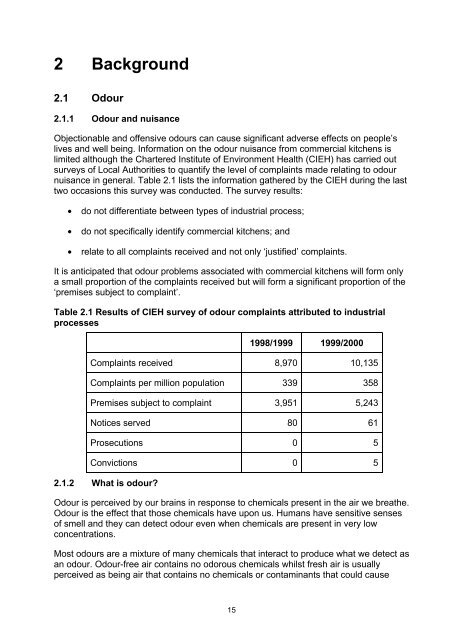Guidance on the Control of Odour and Noise from ... - Defra
Guidance on the Control of Odour and Noise from ... - Defra
Guidance on the Control of Odour and Noise from ... - Defra
Create successful ePaper yourself
Turn your PDF publications into a flip-book with our unique Google optimized e-Paper software.
2 Background<br />
2.1 <strong>Odour</strong><br />
2.1.1 <strong>Odour</strong> <strong>and</strong> nuisance<br />
Objecti<strong>on</strong>able <strong>and</strong> <strong>of</strong>fensive odours can cause significant adverse effects <strong>on</strong> people’s<br />
lives <strong>and</strong> well being. Informati<strong>on</strong> <strong>on</strong> <strong>the</strong> odour nuisance <strong>from</strong> commercial kitchens is<br />
limited although <strong>the</strong> Chartered Institute <strong>of</strong> Envir<strong>on</strong>ment Health (CIEH) has carried out<br />
surveys <strong>of</strong> Local Authorities to quantify <strong>the</strong> level <strong>of</strong> complaints made relating to odour<br />
nuisance in general. Table 2.1 lists <strong>the</strong> informati<strong>on</strong> ga<strong>the</strong>red by <strong>the</strong> CIEH during <strong>the</strong> last<br />
two occasi<strong>on</strong>s this survey was c<strong>on</strong>ducted. The survey results:<br />
• do not differentiate between types <strong>of</strong> industrial process;<br />
• do not specifically identify commercial kitchens; <strong>and</strong><br />
• relate to all complaints received <strong>and</strong> not <strong>on</strong>ly ‘justified’ complaints.<br />
It is anticipated that odour problems associated with commercial kitchens will form <strong>on</strong>ly<br />
a small proporti<strong>on</strong> <strong>of</strong> <strong>the</strong> complaints received but will form a significant proporti<strong>on</strong> <strong>of</strong> <strong>the</strong><br />
‘premises subject to complaint’.<br />
Table 2.1 Results <strong>of</strong> CIEH survey <strong>of</strong> odour complaints attributed to industrial<br />
processes<br />
15<br />
1998/1999 1999/2000<br />
Complaints received 8,970 10,135<br />
Complaints per milli<strong>on</strong> populati<strong>on</strong> 339 358<br />
Premises subject to complaint 3,951 5,243<br />
Notices served 80 61<br />
Prosecuti<strong>on</strong>s 0 5<br />
C<strong>on</strong>victi<strong>on</strong>s 0 5<br />
2.1.2 What is odour?<br />
<strong>Odour</strong> is perceived by our brains in resp<strong>on</strong>se to chemicals present in <strong>the</strong> air we brea<strong>the</strong>.<br />
<strong>Odour</strong> is <strong>the</strong> effect that those chemicals have up<strong>on</strong> us. Humans have sensitive senses<br />
<strong>of</strong> smell <strong>and</strong> <strong>the</strong>y can detect odour even when chemicals are present in very low<br />
c<strong>on</strong>centrati<strong>on</strong>s.<br />
Most odours are a mixture <strong>of</strong> many chemicals that interact to produce what we detect as<br />
an odour. <strong>Odour</strong>-free air c<strong>on</strong>tains no odorous chemicals whilst fresh air is usually<br />
perceived as being air that c<strong>on</strong>tains no chemicals or c<strong>on</strong>taminants that could cause
















